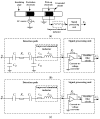New C4D Sensor with a Simulated Inductor
- PMID: 26828493
- PMCID: PMC4801543
- DOI: 10.3390/s16020165
New C4D Sensor with a Simulated Inductor
Abstract
A new capacitively coupled contactless conductivity detection (C(4)D) sensor with an improved simulated inductor is developed in this work. The improved simulated inductor is designed on the basis of the Riordan-type floating simulated inductor. With the improved simulated inductor, the negative influence of the coupling capacitances is overcome and the conductivity measurement is implemented by the series resonance principle. The conductivity measurement experiments are carried out in three pipes with different inner diameters of 3.0 mm, 4.6 mm and 6.4 mm, respectively. The experimental results show that the designs of the new C(4)D sensor and the improved simulated inductor are successful. The maximum relative error of the conductivity measurement is less than 5%. Compared with the C(4)D sensors using practical inductors, the measurement accuracy of the new C(4)D sensor is comparable. The research results also indicate that the adjustability of a simulated inductor can reduce the requirement for the AC source and guarantee the interchangeableness. Meanwhile, it is recommended that making the potential of one terminal of a simulated inductor stable is beneficial to the running stability. Furthermore, this work indirectly verifies the possibility and feasibility of the miniaturization of the C(4)D sensor by using the simulated inductor technique and lays a good foundation for future research work.
Keywords: capacitively coupled contactless conductivity detection (C4D); conductivity measurement; contactless conductivity detection (CCD); series resonance; simulated inductor.
Figures









Similar articles
-
On the Design of a New Simulated Inductor Using a Contactless Electrical Tomography System as an Example.Sensors (Basel). 2019 May 29;19(11):2463. doi: 10.3390/s19112463. Sensors (Basel). 2019. PMID: 31146459 Free PMC article.
-
Online measurement of conductivity/permittivity of fluid by a new contactless impedance sensor.Rev Sci Instrum. 2017 May;88(5):055111. doi: 10.1063/1.4983208. Rev Sci Instrum. 2017. PMID: 28571398
-
A Low Excitation Working Frequency Capacitively Coupled Contactless Conductivity Detection (C4D) Sensor for Microfluidic Devices.Sensors (Basel). 2021 Sep 24;21(19):6381. doi: 10.3390/s21196381. Sensors (Basel). 2021. PMID: 34640701 Free PMC article.
-
[Capacitively coupled contactless conductivity detection in capillary electrophoresis].Se Pu. 2005 Mar;23(2):152-7. Se Pu. 2005. PMID: 16013558 Review. Chinese.
-
Recent applications and developments of capacitively coupled contactless conductivity detection (CE-C4D) in capillary electrophoresis.Biomed Chromatogr. 2014 Nov;28(11):1502-6. doi: 10.1002/bmc.3230. Epub 2014 May 10. Biomed Chromatogr. 2014. PMID: 24816678 Review.
Cited by
-
How Geometry Affects Sensitivity of a Differential Transformer for Contactless Characterization of Liquids.Sensors (Basel). 2021 Mar 29;21(7):2365. doi: 10.3390/s21072365. Sensors (Basel). 2021. PMID: 33805361 Free PMC article.
-
Polymer-Based Contactless Conductivity Detector for Europan Salts (PolyCoDES).Sensors (Basel). 2025 Jan 27;25(3):775. doi: 10.3390/s25030775. Sensors (Basel). 2025. PMID: 39943415 Free PMC article.
-
Bacterial Concentration Detection using a PCB-based Contactless Conductivity Sensor.Micromachines (Basel). 2019 Jan 14;10(1):55. doi: 10.3390/mi10010055. Micromachines (Basel). 2019. PMID: 30646622 Free PMC article.
-
Differential Inductive Sensing System for Truly Contactless Measuring of Liquids' Electromagnetic Properties in Tubing.Sensors (Basel). 2021 Aug 17;21(16):5535. doi: 10.3390/s21165535. Sensors (Basel). 2021. PMID: 34450977 Free PMC article.
-
On the Design of a New Simulated Inductor Using a Contactless Electrical Tomography System as an Example.Sensors (Basel). 2019 May 29;19(11):2463. doi: 10.3390/s19112463. Sensors (Basel). 2019. PMID: 31146459 Free PMC article.
References
-
- Tower O.F. The Conductivity of Liquids: Methods, Results, Chemical Applications and Theoretical Considerations. Chemical Publishing Company; Easton, PA, USA: 1905.
-
- De Diego A., Usobiaga A., Fernandez L.A., Madariaga J.M. Application of the electrical conductivity of concentrated electrolyte solutions to industrial process control and design: From experimental measurement towards prediction through modeling. Trends. Anal. Chem. 2001;20:65–78. doi: 10.1016/S0165-9936(00)00081-9. - DOI
-
- Bard A.J., Faulkner L.R. Electrochemical Methods Fundamentals and Application. John Wiley & Sons, Inc.; New York, NY, USA: 2001.
-
- Hamann C.H., Hamnett A., Vielstich W. Electrochemistry. 2nd ed. Wiley-VCH Verlag GmbH & Co.KGaA; Weinheim, Germany: 2007.
Publication types
LinkOut - more resources
Full Text Sources
Other Literature Sources

